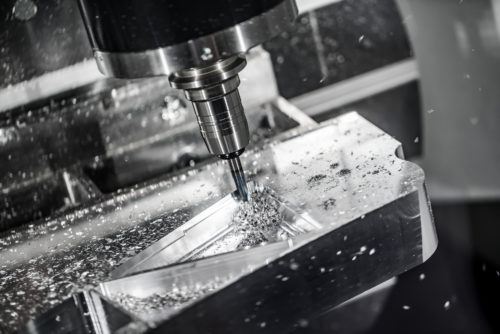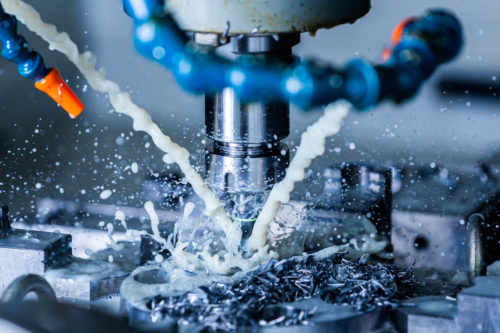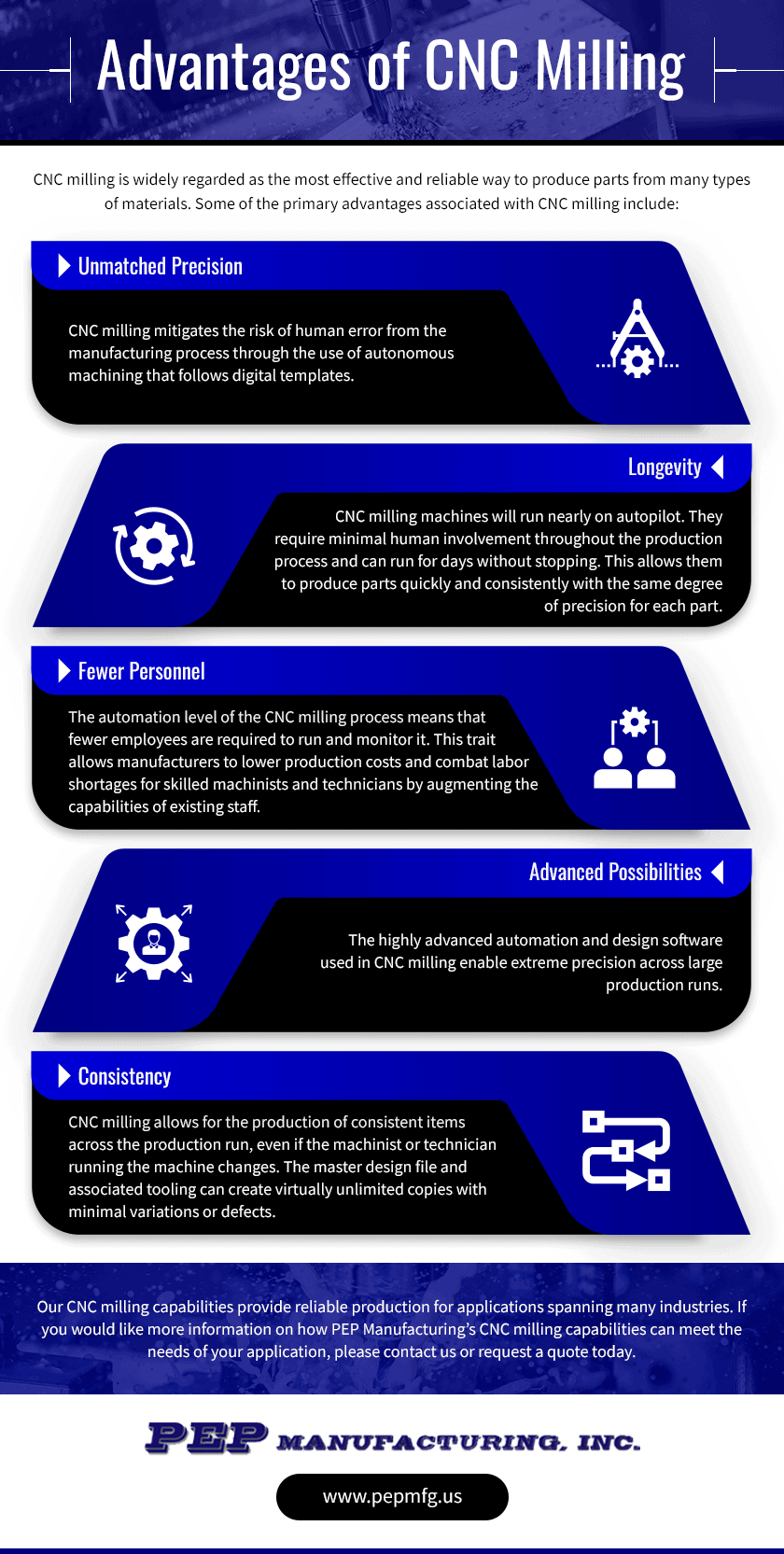
The speed and precision that CNC milling machines deliver have revolutionized manufacturing by creating the ability to mass-produce highly detailed components faster and more accurately than traditional methods. After an operator has programmed and set a CNC machine one time, they can quickly produce countless pieces with excellent part-to-part repeatability. These qualities make CNC milling ideal for high-volume manufacturing parts and components from a range of materials, including metal, glass, plastic, and wood.
What is the CNC Milling Process?
The first stage of the CNC milling process involves inserting a workpiece into a CNC machine’s holding device or onto its work surface. Next, the required milling tools get installed in the machine’s spindle. Depending on the specific machine and the design requirements, the milling process can occur horizontally or vertically. After the workpiece has been secured, the tooling attached, and the machine programmed, an operator can use the machine’s interface to start the program and begin the milling process.
The workpiece is maneuvered and positioned for the cutting tool-based instructions translated from a computer-aided design (CAD) file by computer-aided manufacturing (CAM) software. There are three possible methods for the machine to perform the cuts: by slowly feeding the workpiece into a stationary tool, by the tool moving through a stationary workpiece, or some combination of these methods. Having the workpiece and the cutter move in the same direction is known as climb milling. Another common method, known as conventional milling, involves the cutter and workpiece moving in opposite directions.
The main purpose of milling is to gradually remove material in order to produce a desired form or shape. Milling is often performed as a secondary or finishing process for workpieces that have already undergone some other fabrication process to add special features, such as threads, slots, or holes. However, CNC milling also functions as a start-to-finish machining process in many applications.
The process of CNC milling is completed in phases. During the first phase, the cutting tool will make small cuts to form the basics of the design shape. After this initial pass, the tool will then pass over the workpiece several more times, each time making more cuts to achieve the exact specifications of the design. Depending on the complexity or intricacy of the design, multiple machine setups may be necessary.
A milling cutter can make numerous types of shapes, holes, and impressions by moving along multiple axes. CNC milling machines have three to five axes which allow them to produce parts that would be impossible to produce otherwise. In the milling process, X and Y represent horizontal axes of movement, the Z-axis represents vertical movement, and W represents diagonal movement along a vertical plane. CNC milling machines can often conduct operations on multiple axes simultaneously to reduce the number of passes and increase the speed of production.
Advantages of CNC Milling
CNC milling is widely regarded as the most effective and reliable way to produce parts from many types of materials. Some of the primary advantages associated with CNC milling include:
Unmatched Precision
CNC milling executes designs with extreme precision, making it the preferred choice for some of the most rigorous industries, such as aerospace and medicine. CNC milling mitigates the risk of human error from the manufacturing process through the use of autonomous machining that follows digital templates. So long as the design itself contains no flaws, the resulting accuracy in the finished product is as near to perfection as possible.
Longevity
CNC milling machines will run nearly on autopilot. They require minimal human involvement throughout the production process and can run for days without stopping. This allows them to produce parts quickly and consistently with the same degree of precision for each part. This capability often allows machinists to set equipment to run overnight or during other low-occupancy periods.
Fewer Personnel
The automation level of the CNC milling process means that fewer employees are required to run and monitor it. This trait allows manufacturers to lower production costs and combat labor shortages for skilled machinists and technicians by augmenting the capabilities of existing staff.
Advanced Possibilities
The highly advanced automation and design software used in CNC milling enable extreme precision across large production runs. CNC milling equipment will consistently outperform even the most skilled manual machinist in terms of close-tolerance work, allowing the reliable production of highly complex designs that incorporate a significant variety of shapes, sizes, and textures.
Consistency
CNC milling allows for the production of consistent items across the production run, even if the machinist or technician running the machine changes. The master design file and associated tooling can create virtually unlimited copies with minimal variations or defects. Even the most highly skilled manual operators aren’t able to duplicate a workpiece the way a CNC milling machine can. The design file and tooling can also be removed and reinstalled later to facilitate batch orders.
PEP’s Manufacturing Capabilities
At PEP Manufacturing, our facility is ISO 9001:2015-certified for quality management. We’re fully equipped to handle any CNC milling project with quick turnaround times and rigid quality controls. We have a substantial selection of CNC machining equipment, including:
- (1) 4-axis HAAS Mini Mill Vertical Machining Center
- (2) 4-axis Mori Seiki Dura-Vertical 5100 Vertical Machining Center
- (1) 5-axis Doosan DVF5000 Simultaneous Vertical Machining Center

- Alloy steel
- Carbon steel
- Stainless steel
- Aluminum
- Brass
- Bronze alloys
- Iron
- Inconel®
- Nylon
- Phenolic
- Polytetrafluoroethylene (PTFE)
- Composites
Our highly experienced team provides expert CNC milling services to customers throughout a diverse range of industries. We have extensive experience producing many types of internal parts for diverse applications, including:
- Aerospace
- Heavy equipment
- Hydraulic cylinders
- Marine applications
- Oil and gas
- Tooling
- Transportation
PEP Manufacturing, Inc. has more than 40 years of combined experience in the manufacturing industry. Our team stays updated on the latest machining best practices and delivers high-quality pieces with short lead times. Our CNC milling capabilities provide reliable production for applications spanning many industries. If you would like more information on how PEP Manufacturing’s CNC milling capabilities can meet the needs of your application, please contact us or request a quote today.

